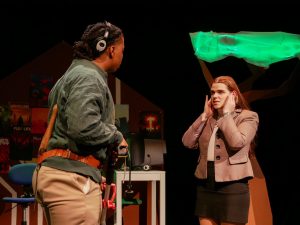LSU School of Theatre’s Lab Show, “Neighborhood 3: Requisition of Doom,” serves as a warning to audiences that is all too applicable to modern-day suburbia and society as a whole.
“Neighborhood 3: Requisition of Doom,” written by Jennifer Haley and directed by Ethan Hood, tells the story of a group of teens as they become more and more absorbed with a new horror video game called Neighborhood 3. The teens’ concerned parents look on helplessly as they try and fail to reconnect with their children.
“I think this show is important right now because of the difference in worldview between the older generation and the current one,” Hood said. “This story predicates on the miscommunication between us and ultimately shows why it is important to make an effort to understand each other.”
The goal of the game, which takes place in a suburban neighborhood identical to their own, is to fight through hordes of zombies in order to reach the Final House and escape the neighborhood. However, it becomes clear that there is more to the game than what meets the eye as events begin to mirror those happening in real life.

The set is simple, featuring distinct tableaus of a kitchen, the front of a house and a teenager’s bedroom, as well as a single light-up tree on the edge. Its simplicity allows the performance of the actors and the message of the play to shine.
The four main actors are each tasked with playing multiple roles, categorized as Mother-Type, Father-Type, Son-Type and Daughter-Type. Despite every role being played by the same people, each character has a clear and distinct personality that highlights the actors’ range and impressive talent.
“Neighborhood 3” provides compelling commentary on suburbia and the dark realities that can hide behind unassuming walls and freshly-mowed lawns. Each character wrestles with serious personal issues, ranging from snowballing-secrets to unfettered fear, that cause their lives to spiral in chaos.
This disconnect between generations is skillfully illustrated through the younger and older characters portrayed in the play.
Madison, an avid player of Neighborhood 3, uses the game as a form of escapism. In an argument with her brother Jared, she questions why she should care about her real life when it is filled with messiness and bad people, such as her alcoholic father who constantly neglects the two siblings. Madison feels trapped in a community that, instead of facing the truth and dealing with its issues, chooses to hide from its problems out of fear.

Tobias, a father obsessed with keeping his lawn tidy, remarks that despite the neighborhood’s picture-perfect exterior, all of the adults are floundering to maintain control of their lives as they lose their grip on their children. He also laments that in trying to deny their growing fear, the parents are simply amplifying it.
The play ends on a startling realization that no matter where the characters move or what they do, they can never escape the neighborhood. In other words, every neighborhood is the same, so even if they were somehow able to get out, the family dynamics and societal expectations they experience now would stay the same. Nothing would change.
“Neighborhood 3” is a thought-provoking cautionary tale that is well worth the watch. The final showings of “Neighborhood 3: Requisition of Doom” are on Feb. 21 and 22 at 7:30 p.m. and Feb. 23 at 2 p.m. Tickets can be purchased here.









